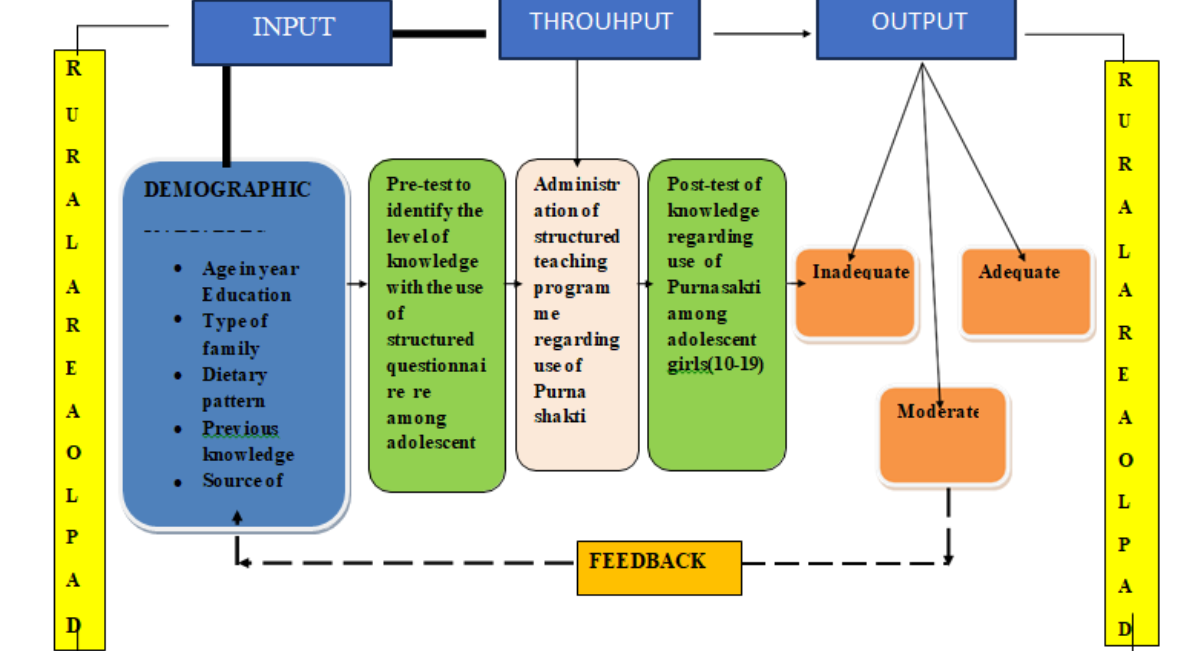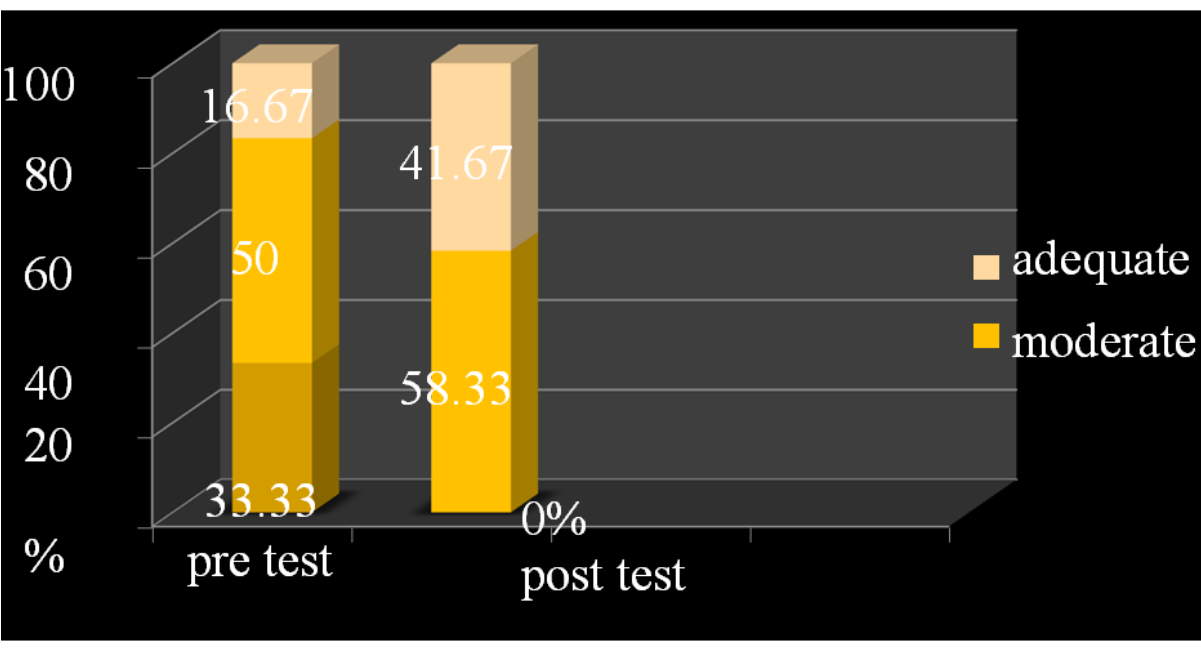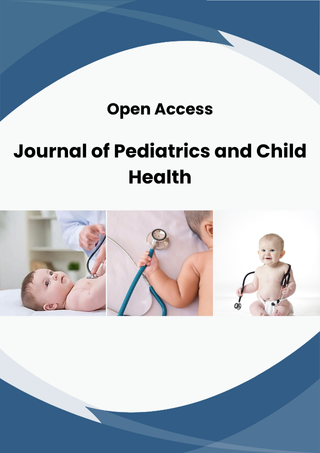ABSTRACT
Research methodology is a way of systematically solving the research problem. It is a science of study how research is done scientifically and this is way that enables the researcher to project a blueprint of the research undertaken. This deals with the methodology selected by the investigators to study the effectiveness of structured teaching programme on knowledge regarding the use of purnashakti among adolescent girls in selected rural area of olpad taluka, Surat, Gujarat [1].
Keywords: Adolescent girl- A girl age is 10-19 years; Purnasakti – The scheme provides health check-ups and referral services to adolescents.
INTRODUCTION
Nutritional deficiencies have widespread consequences, especially in adolescent females. A malnourished female affects her overall health, well-being, and productivity. Further, a malnourished female is likely to give birth to undernourished children, which transcends undernutrition toward future generations. Adolescence is also identified as the second window of opportunity after the first thousand days of life to improve nutritional inadequacies and inadequate growth and development from childhood. WHO defines 'Adolescents' as individuals in the 10-19 years age group [2]. Poshan abhiyan was launched by Hon’ble prime minister on 8th march 2018 in Jhunjhunu district of Rajasthan. The focus of abhiyan is to emphasis on nutritional status of adolescent girls, pregnant women, lactating mothers. It was decided in three categories.
• Bal shakti
• Purna shakti
• Matru shakti
ANALYSIS AND INTERPRETATION
Quantitative approach was used with pre-test post-test design. The structured teaching programme regarding purnashkti among adolescent girls. The study was conducted at Olpad Taluka, Surat,Gujarat. The samples of 60 adolescent girls were selected through non probability convenient sampling technique [3]. A structured knowledge questionnaire was prepared to assess the knowledge of participants. content validity to developed tools and structured teaching programme was established by 5 experts and necessary modification were made as per suggestion. Reliability of the tool was ascertained by karl person’s coefficient correlation (r) method.
Result
The mean pre-test knowledge score was 12.85 and the mean post-test knowledge score was 20.45. significance of the difference between pre-test and post-test knowledge was statistically tested using paired ‘t’ test and it was found significant at 0.05 level (13,12 ,t-2.00, respectively). There was significant increase in the knowledge of the sample after administration of the structured teaching programme regarding purnashkti among adolescent girls. Hence, it is concluded that structured teaching programme was effective in improving the knowledge of the adolescent girls in the selected rural area at Olpad Taluka, Surat, Gujarat.
OBJECTIVES OF STUDY
• To assess the knowledge regarding use of Purnashkti among adolescent girls before and after administration of structured teaching programme.
• To determine the effectiveness of structured teaching programme regarding use of Purnashkti among adolescent girls.
• To find out the associations between the post- test levels of knowledge score regarding use of Purnashkti with selected socio demographic variables.
HYPOTHESIS
• H1: There is a significant difference between the mean Pre-test and post- test knowledge score regarding use of Purnashkti among adolescent girls at 0.05 level of significance.
• H2: There is a significant association between pre –test knowledge score regarding use of Purnashkti with their selected demographic variables among adolescent girls at 0.05 level of significance [4].

Figure 1: Conceptual frame work
Note: *Dotted line is not included in this study
METHODOLOGY
Research methodology is a way of systematically solving the research problem. It is a science of study how research is done scientifically and this is way which enables the researcher to project a blue print of the research undertaken [5].
This deals with the methodology, selected by the investigators to study the effectiveness of structured teaching programme on knowledge regarding use of purnashakti among adolescent girls in selected rural area of olpad taluka, Surat, Gujarat.
Research Approach: Quantitative Research Approach
Research Design: One-group pre test post test research design
VARIABLES:
1) Research variables- Knowledge regarding use of purnashakti.
2) Demographic variables-age in year, education, type of family, monthly income, dietary pattern, previous knowledge, source of information [6].
Research Setting:
This present study was conducted in the selected rural area at Olpad Taluka, Surat.
Sampling Technique:
Non probability convenient sampling technique
Targeted Population:
Adolescent girls 10 to 19 years.
Criteria for sample selection:
1) Adolescent girls who are willing to participate
2) Adolescent girls who are understand Gujarati and English
DELIMITATION
This study is delimited to: 60 Adolescent girls available at the time of data collection at selected rural area at olpad taluka, Surat, Gujarat [7, 8].
MAJOR FINDINGS OF THE STUDY:
In this research study major findings in major Age group is between 17 to 19 years(45%), Type of family major finding is nuclear family (55%),Type of diet major finding is non Vegetarian(60%). The pre-test score was 12.85 and post-test score was 20.43 and standard deviation of pre-test score was 4.29 and standard deviation of post-test score was 3.27 and calculated ‘t’ score was 5.42, and the tabulated ‘t’ value is 2 [9].

Figure 2: Bar diagram showing that score of pre test and post test score of adolescent girls
|
Sr. . no |
Demographic Variable |
Inadequate |
Moderate |
Adequate |
Chi Square X2 |
df |
Tabulated Value (S/NS) |
|
1. |
Age in year |
||||||
|
10 to 13year |
7 |
4 |
4 |
2.213 |
4 |
9.48 S |
|
|
14 to 16 year |
7 |
8 |
3 |
||||
|
17 to 19 year |
12 |
9 |
6 |
||||
|
2 |
Education |
||||||
|
Primary |
7 |
4 |
4 |
2.213 |
4 |
9.48 S |
|
|
Secondary |
7 |
8 |
3 |
||||
|
Higher secondary |
12 |
9 |
6 |
||||
|
3 |
Type of family |
||||||
|
Joint |
4 |
6 |
2 |
2.143 |
6 |
12.59 S |
|
|
Nuclear |
13 |
14 |
6 |
||||
|
Extended |
2 |
4 |
0 |
||||
|
Single Parent |
3 |
5 |
1 |
||||
|
4 |
Dietary pattern |
||||||
|
Vegetarian |
4 |
8 |
3 |
3.442 |
4 |
9.48 S |
|
|
Non vegetarian |
12 |
15 |
9 |
||||
|
Mix |
3 |
6 |
0 |
||||
|
5 |
Previous knowledge |
||||||
|
Yes |
14 |
12 |
10 |
0.579 |
2 |
5.99 S |
Table 1: Association between Post Test Level Of Knowledge Score Of Demographic Variables
DISCUSSION
The finding of the study have been discussed with references to the objectives and hypothesis. The pre- test knowledge score among the adolescent girls were found less in selected rural areas of olpad taluka, surat. This indicate the need of the adolescent girls importing necessary knowledge score of adolescent girls regarding and its impact on health was increased after administration of structured teaching program. This show the effectiveness of planned teaching program. Finding from the research analysis revealed that pre-test score of adolescent girl of experimental group was improved after exposure to informational structured teaching programme regarding use of purnashakti [10].
CONCLUSION
It is concluded, the effectiveness of structured teaching programme regarding purnashakti among adolescent girl in selected rural area of olpad taluka, surat, Gujarat. It shows that, the study was very effective in improving the level of knowledge regarding purnashakti.
REFERENCES
- Stanhope M, Lancaster J. Community & public health nursing. 2000. [Google Scholar]
- Stanhope M, Knollmueller RN. Handbook of community-based and home health nursing practice: tools for assessment, intervention and education. 2000. [Google Scholar]
- Freeman RB. Community health nursing practice. JONA: The Journal of Nursing Administration. 197;1(2):7. [Google Scholar]
- Edelman CL, Mandle CL. Health Promotion Throughout the Life Span-Pageburst on VitalSource. Elsevier Health Sciences; 2009. [Google Scholar]
- Bomar PJ. Promoting health in families: Applying family research and theory to nursing practice. 2004.] [Google Scholar]
- Book H. Guidline one integrated MCH FP services. [Google Scholar]
- Spradley BW, Judith AA. Community health nursing. Conceptsand practice. 2005. [Google Scholar]
- Bullough B, Bullough VL. Nursing in the community. 1990. [Google Scholar]
- Daviec, J.B. Meredith. “ COMMUNITY HEALTH PREVENTIVE MEDICIENE & SOCIAL SEVICES” 4th edition. [PubMed]
- Dibie R, Barekew M. HEALTH POLICY AND CHALLENGES IN ETHIOPIA. [Google Scholar]
Indexed In
DOAJ
CrossRef
PubMed
MEDLINE
ResearchBib
OAJI
Sindexs
EBSCO A-Z / Host
OCLC - WorldCat
Journal Flyer


